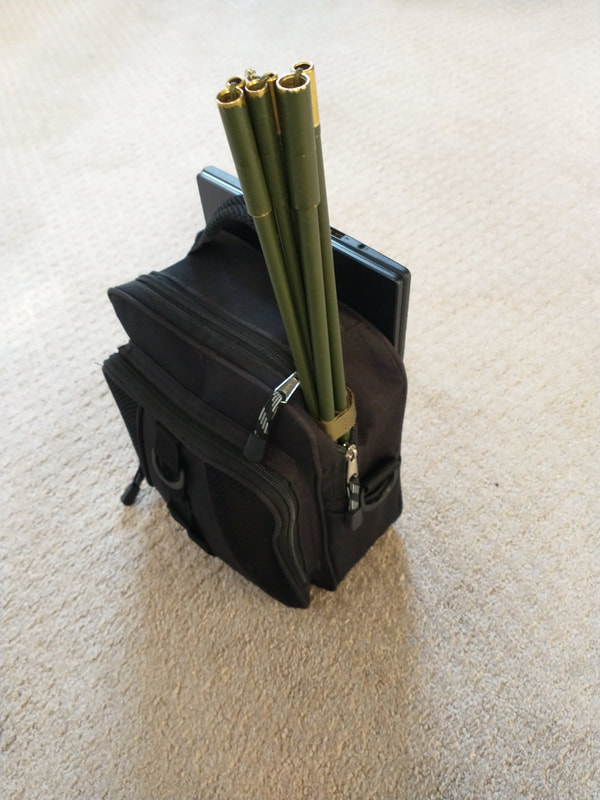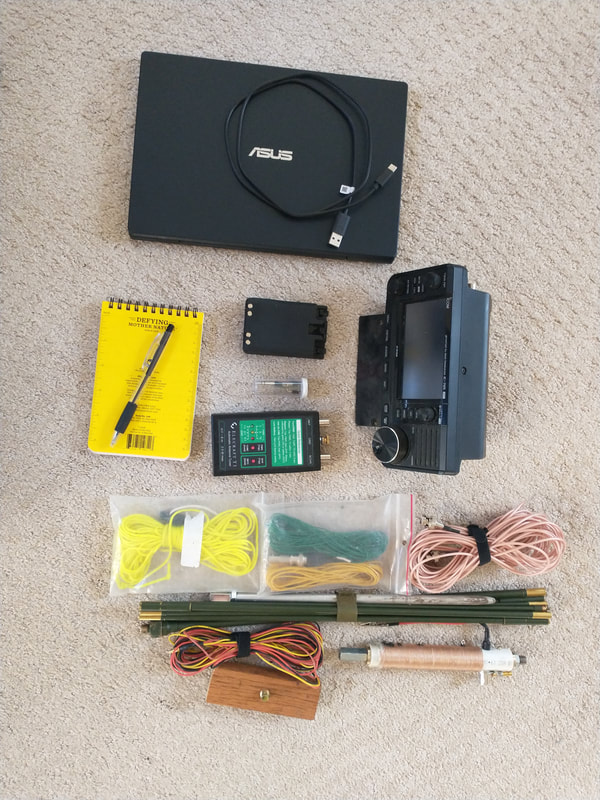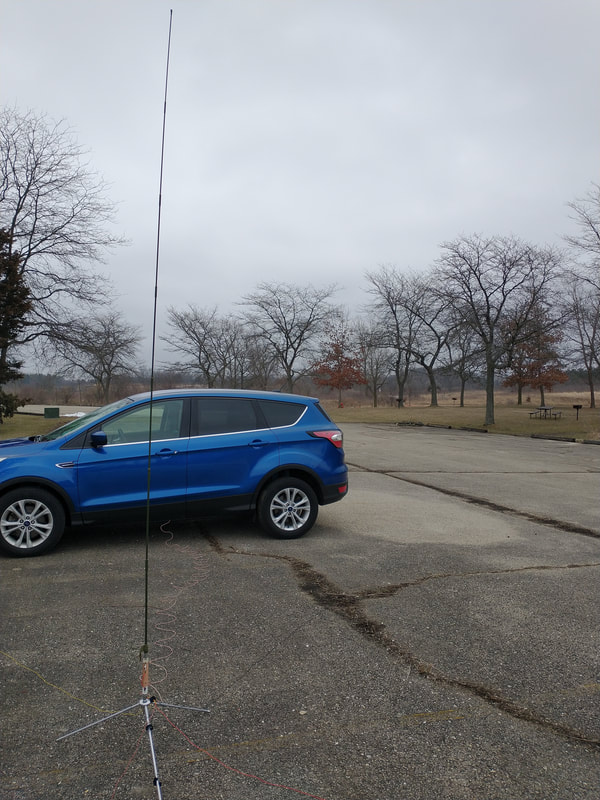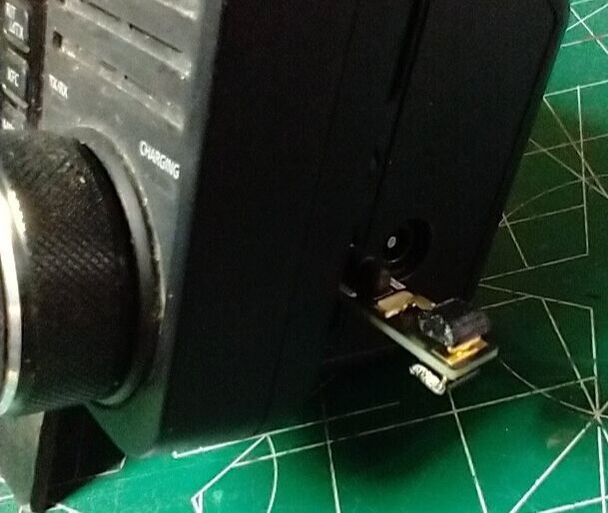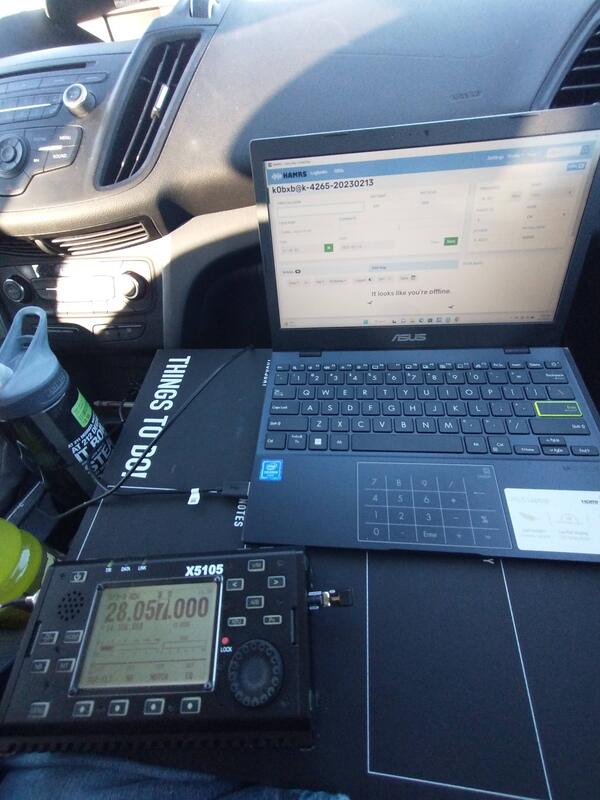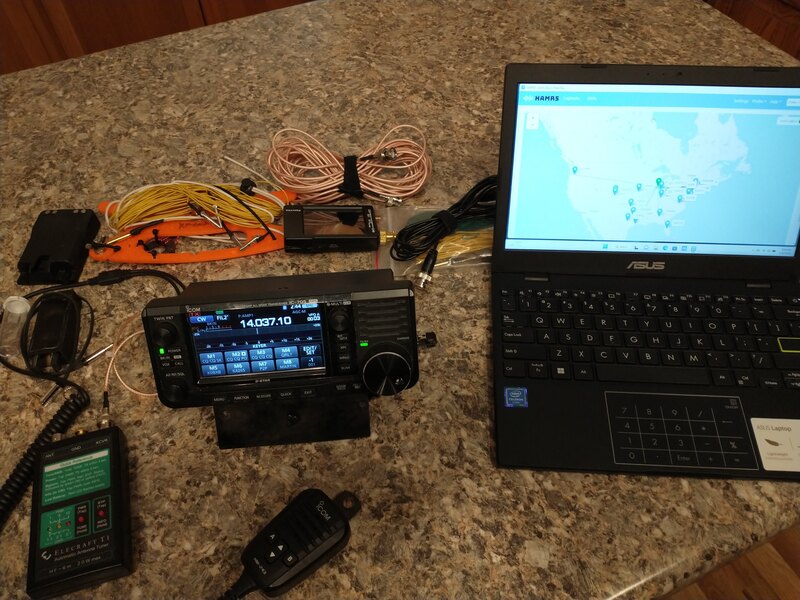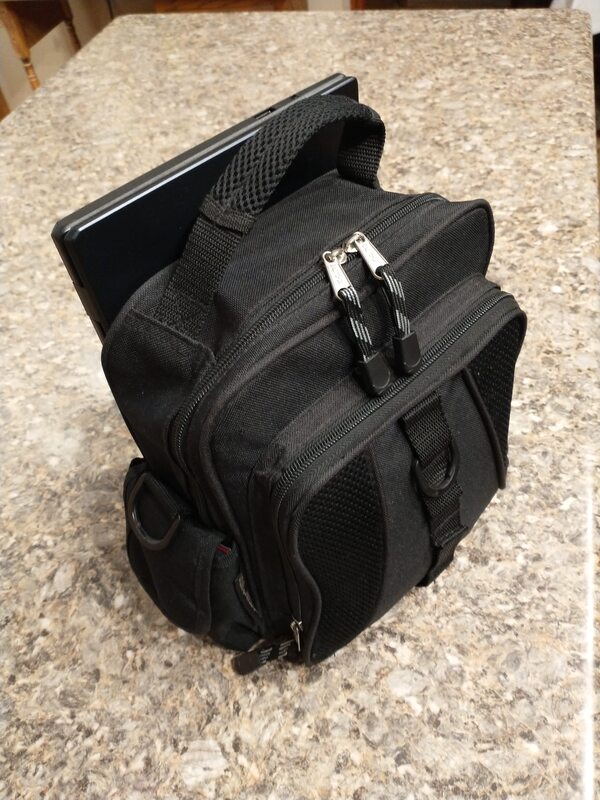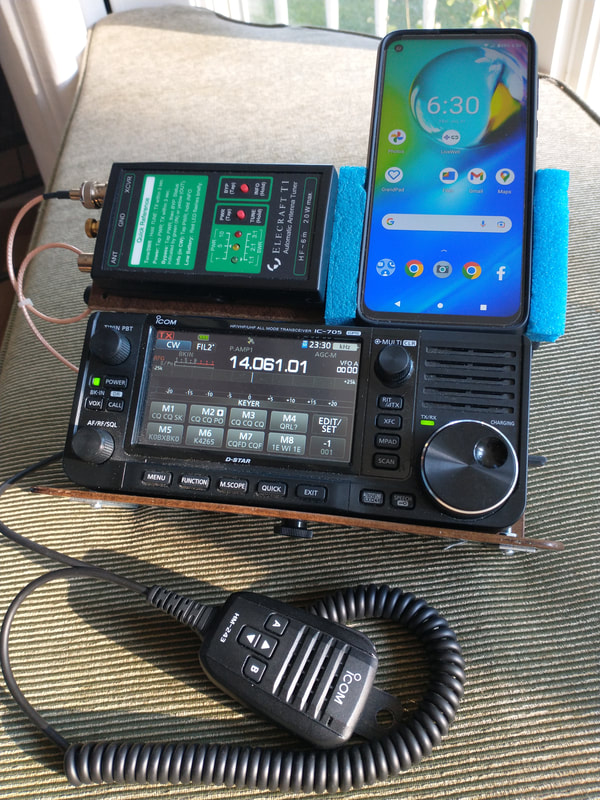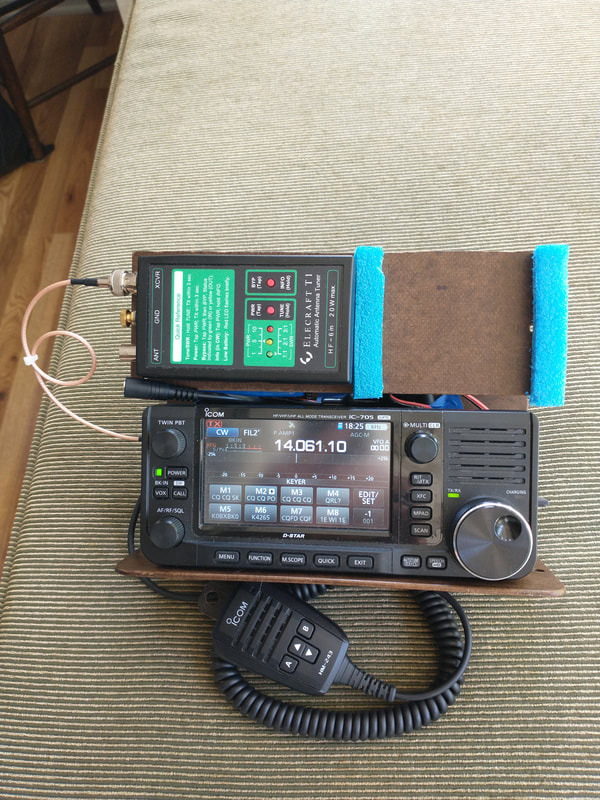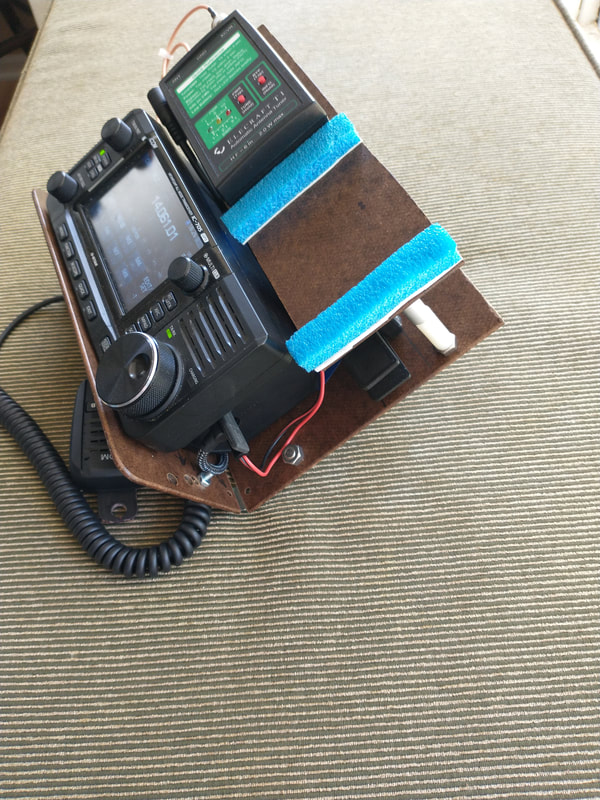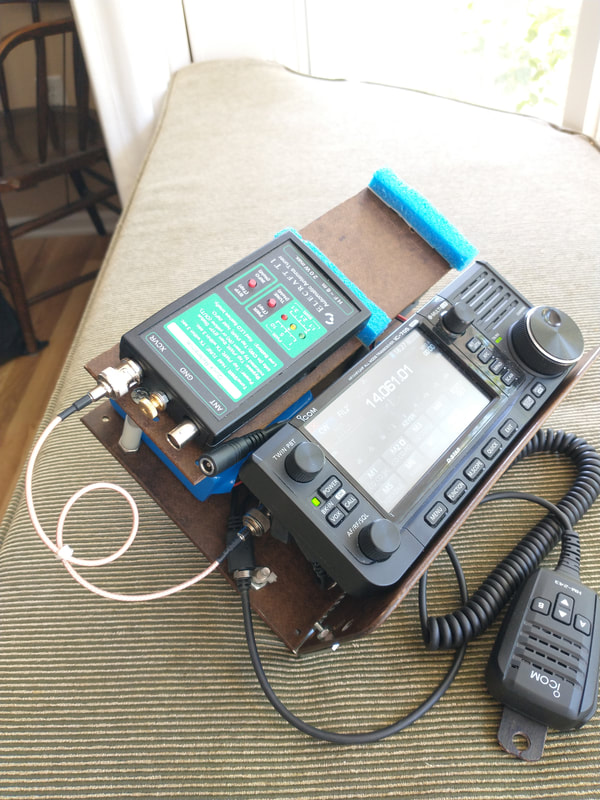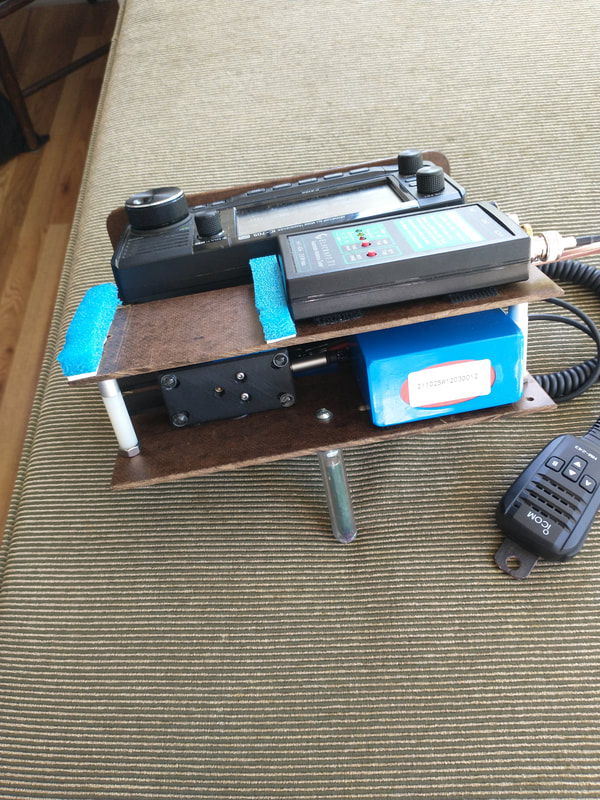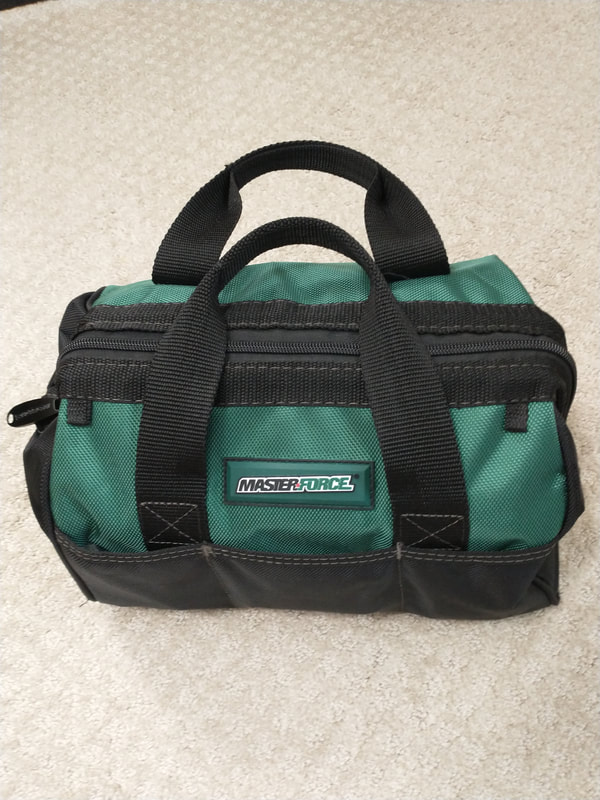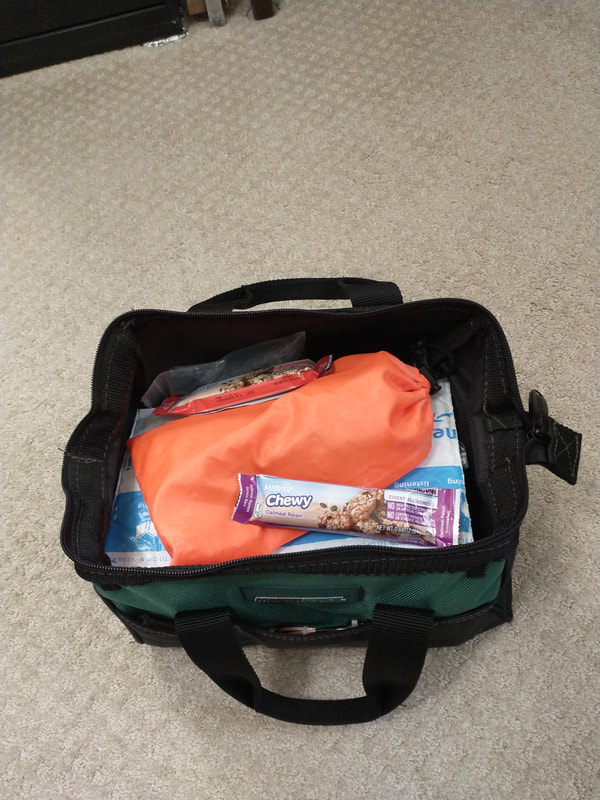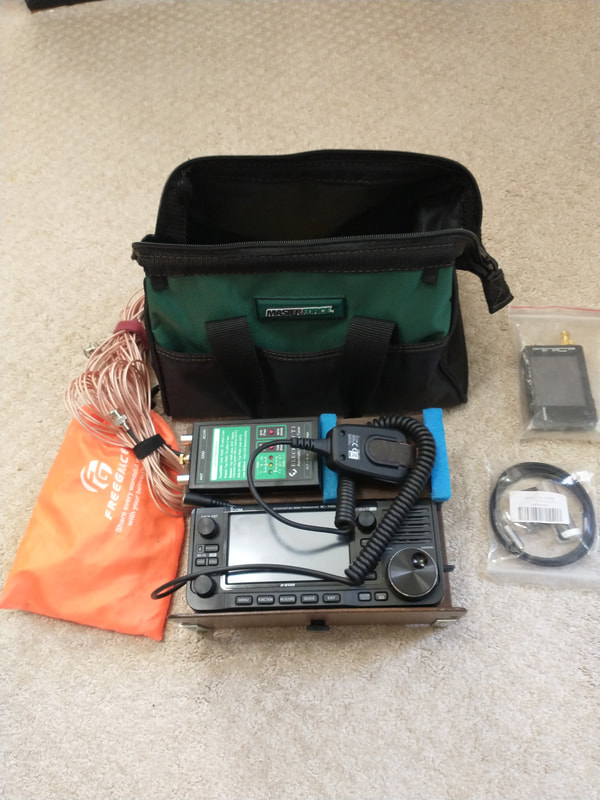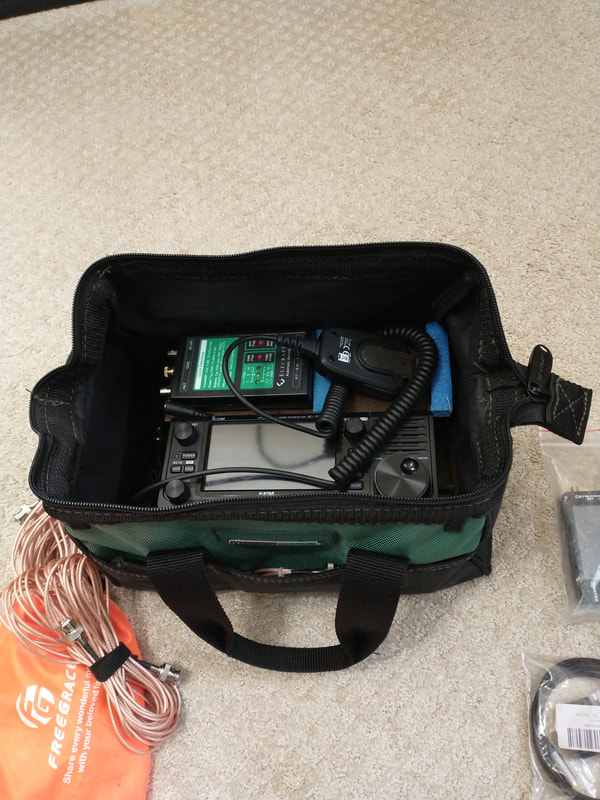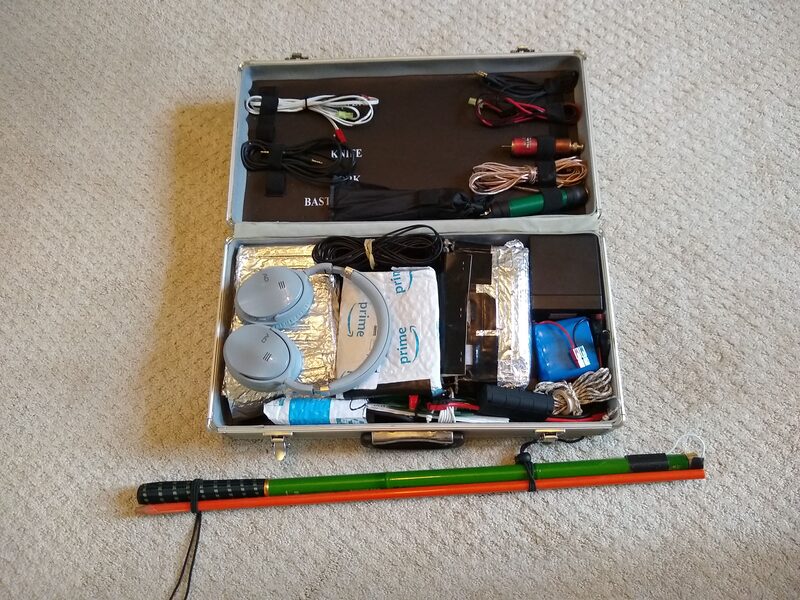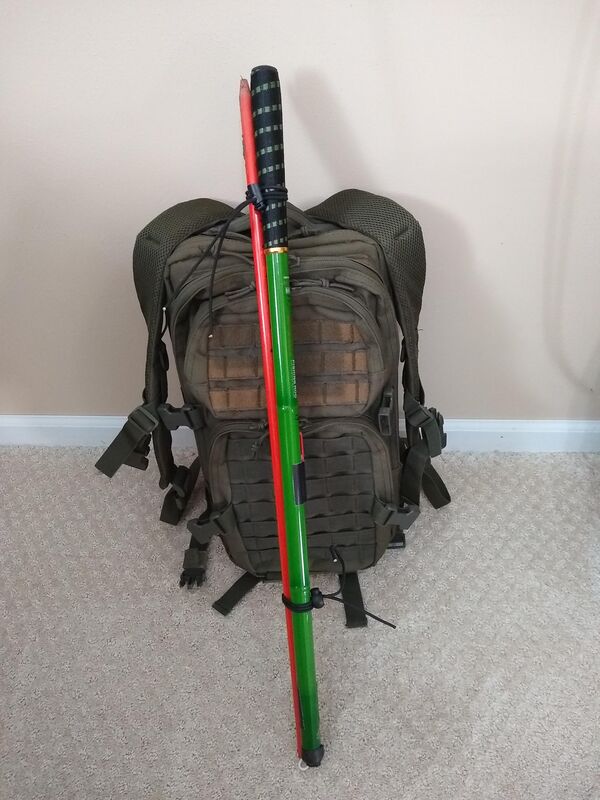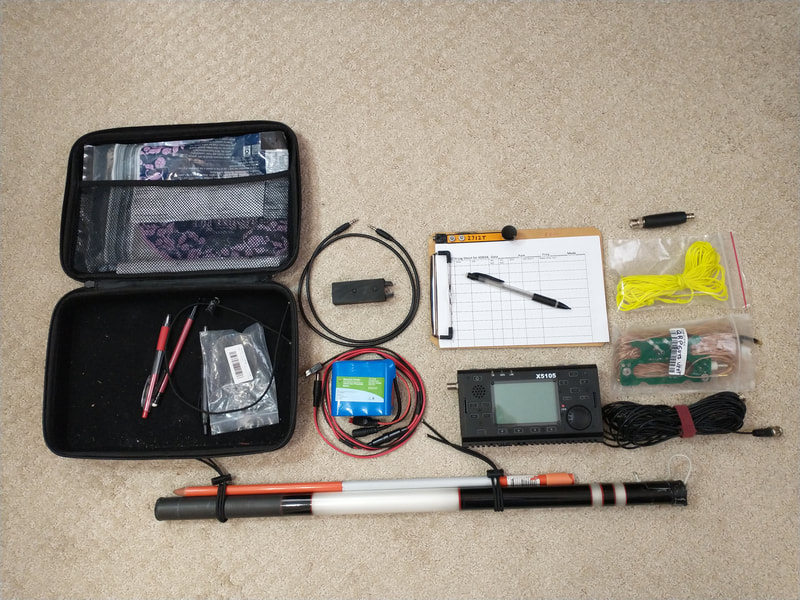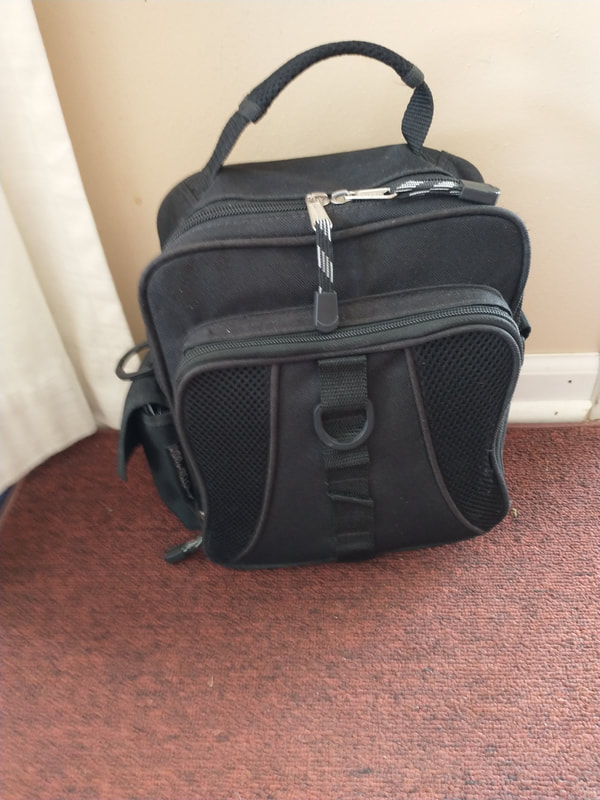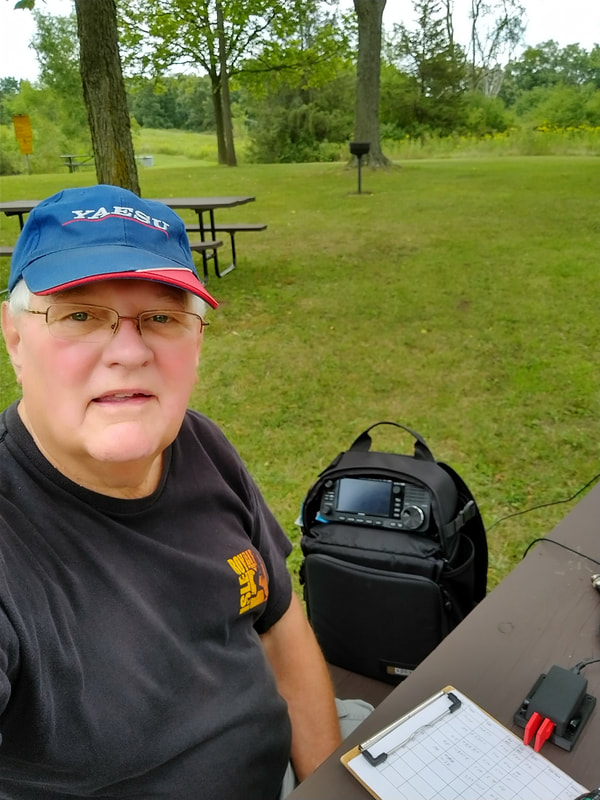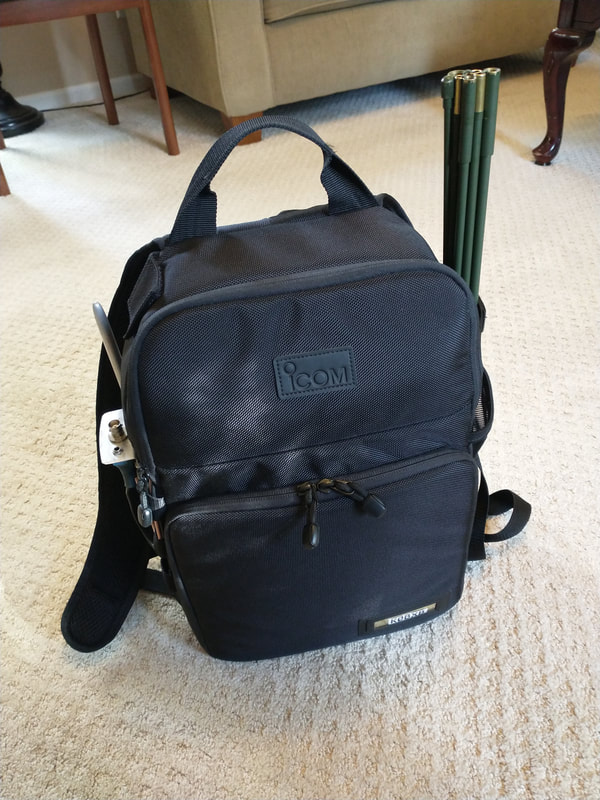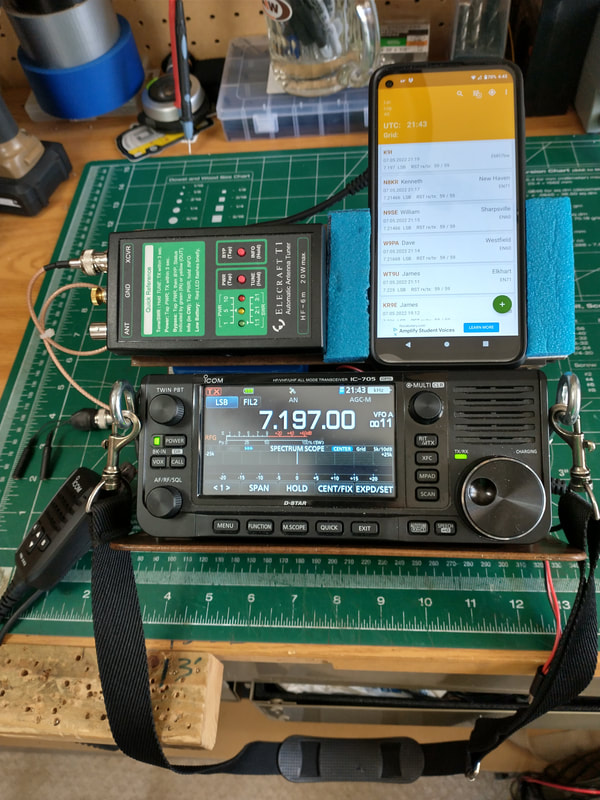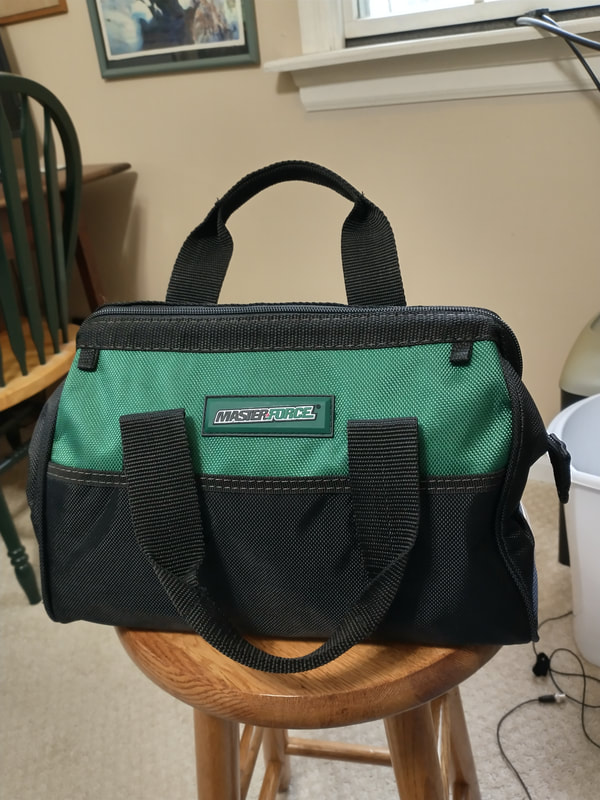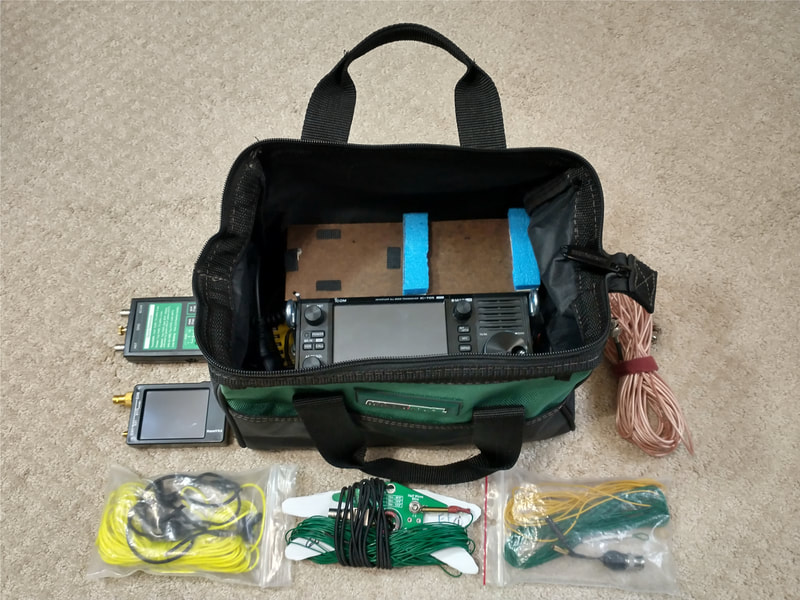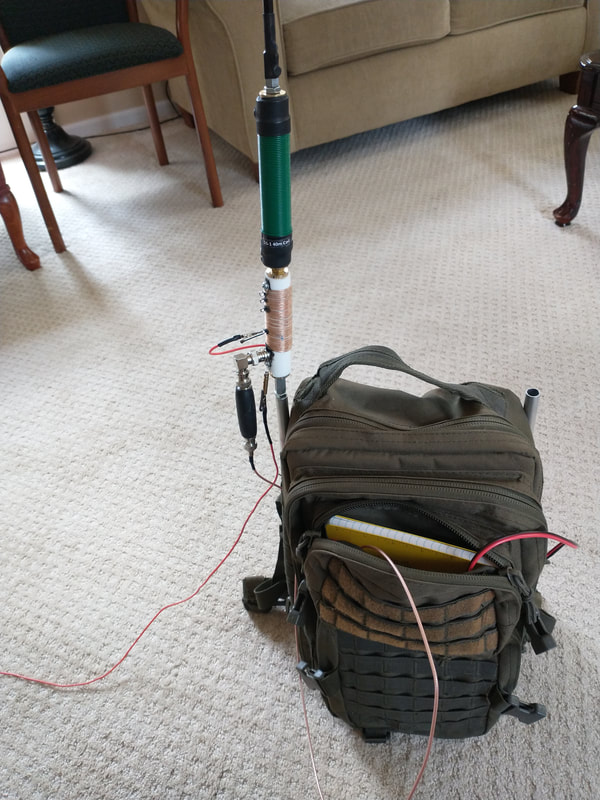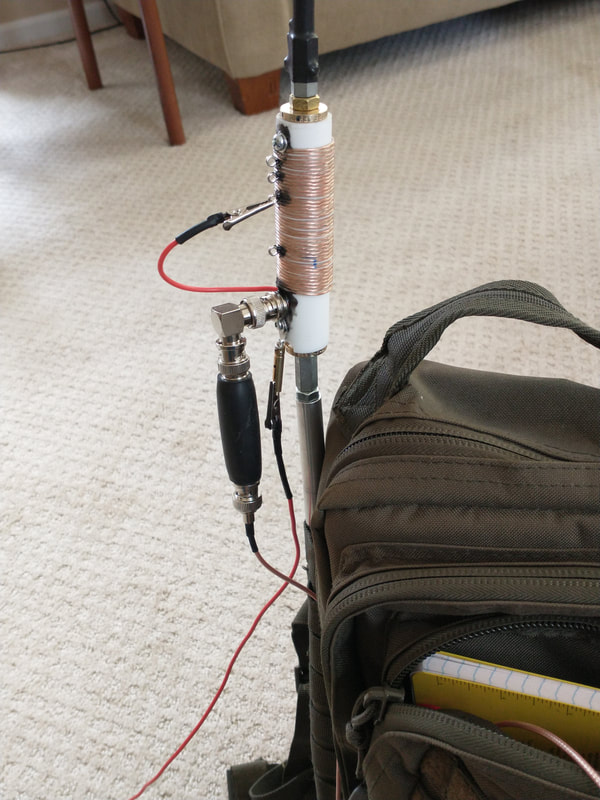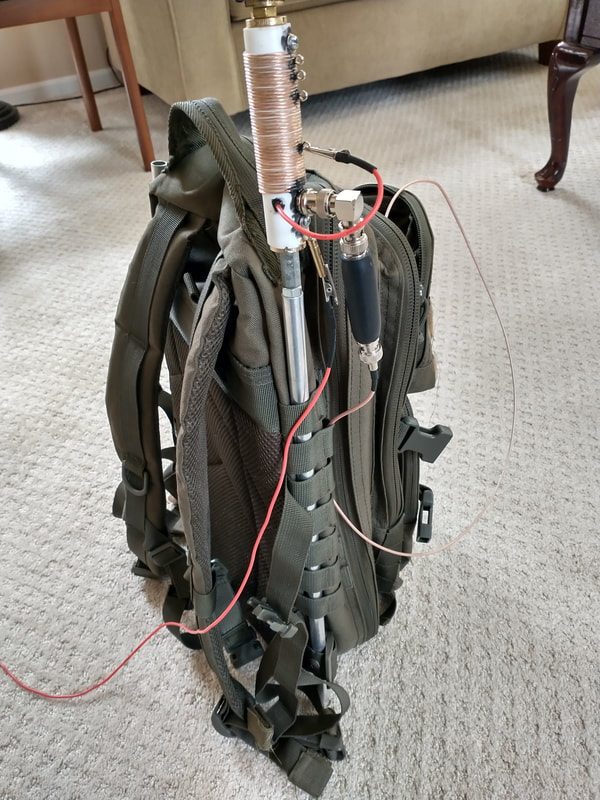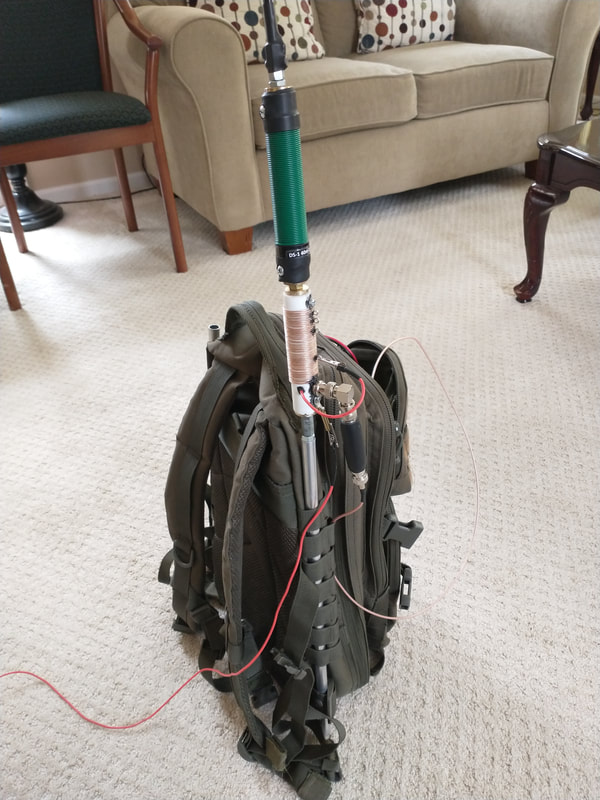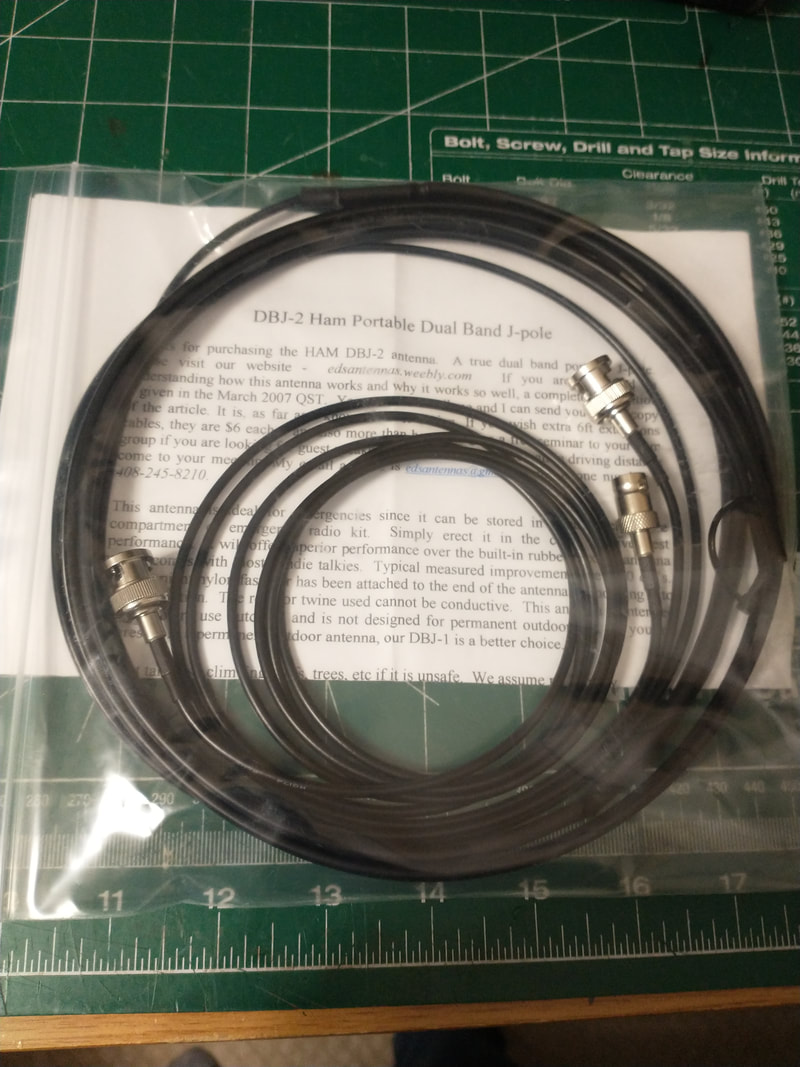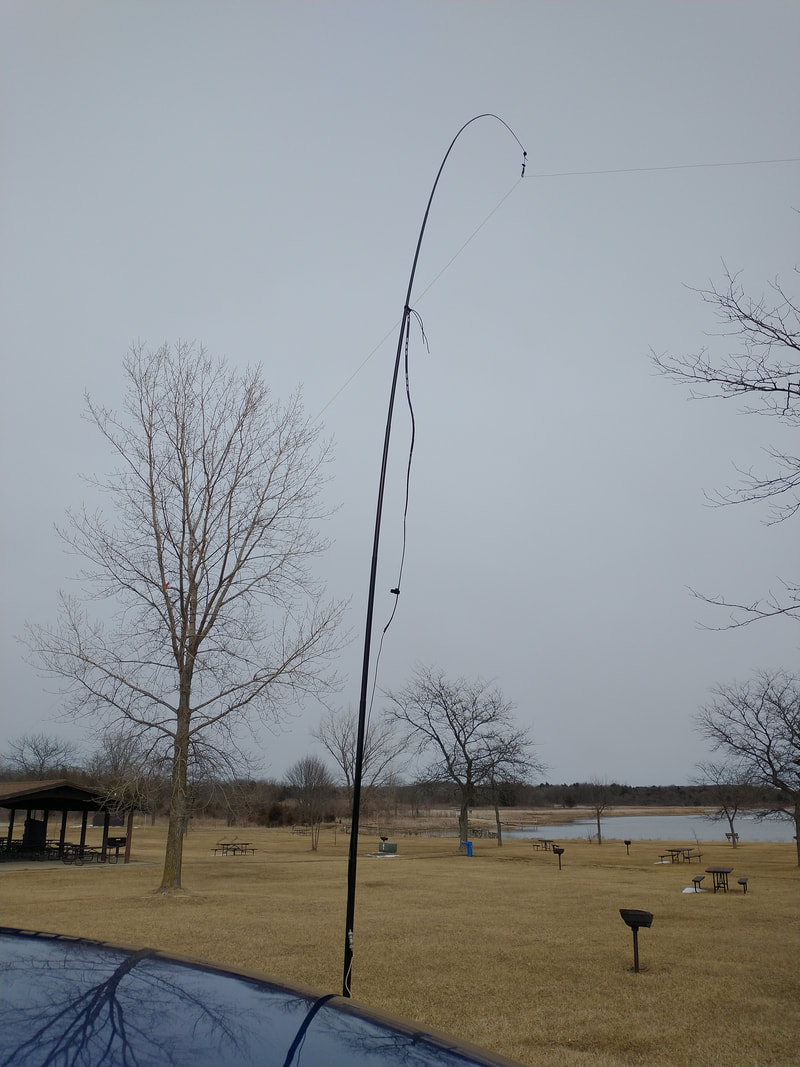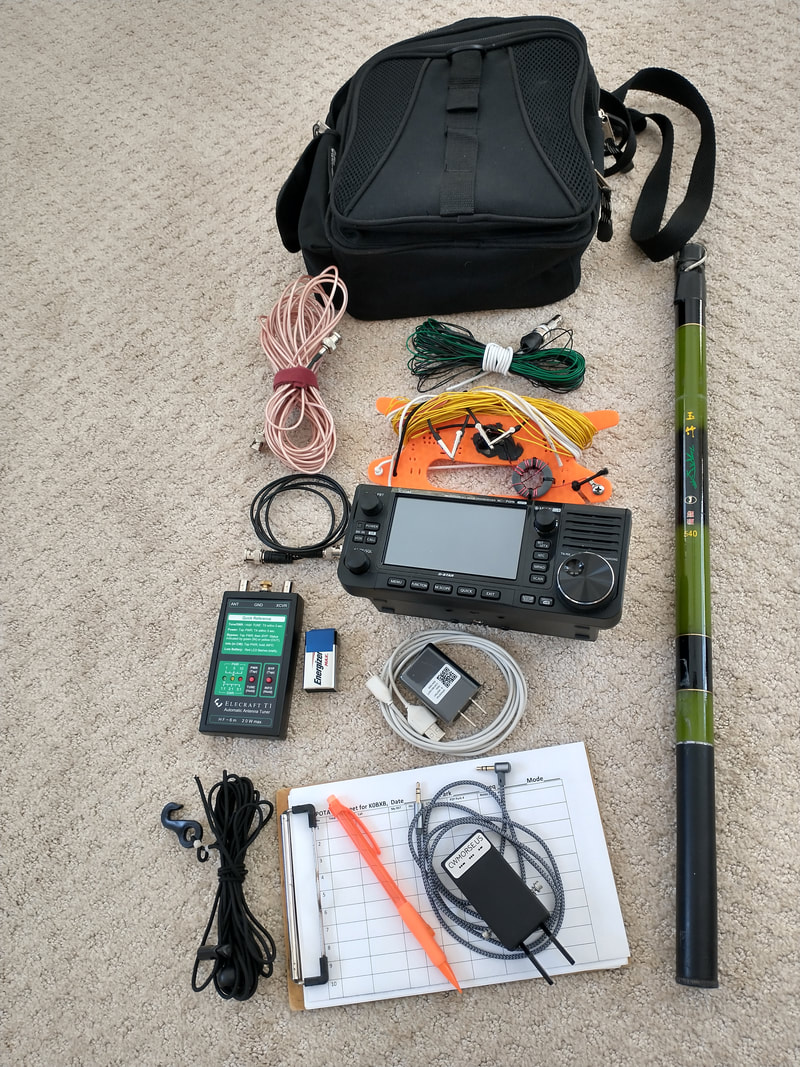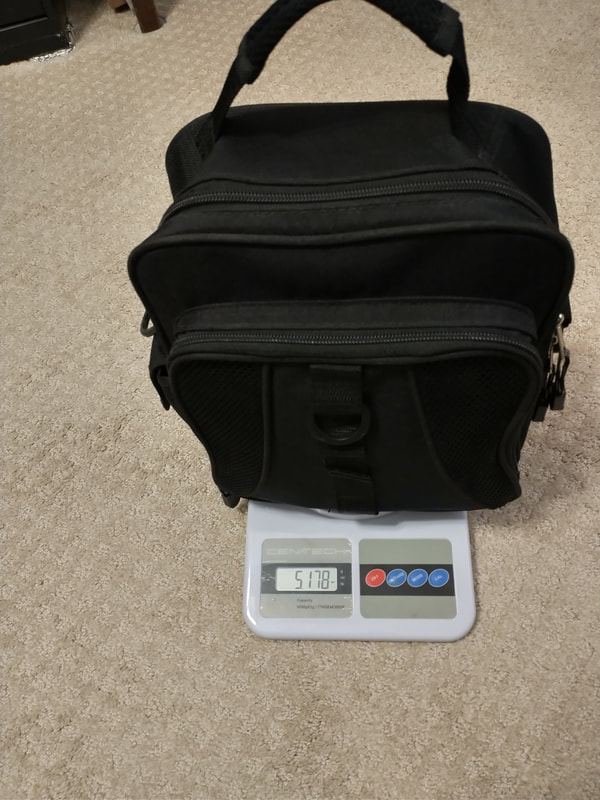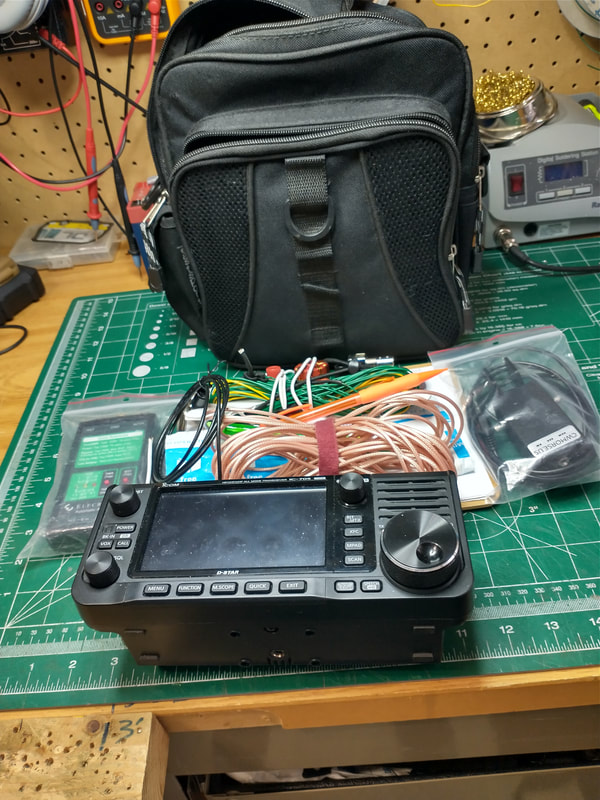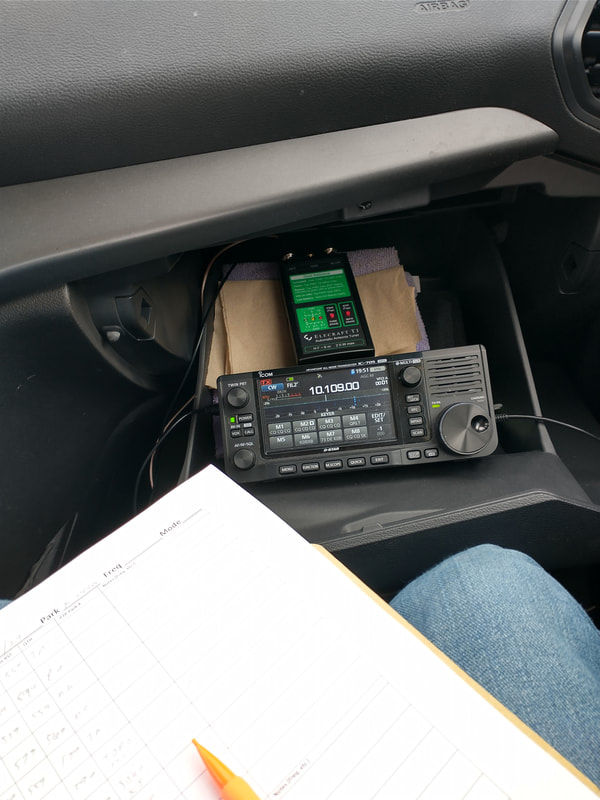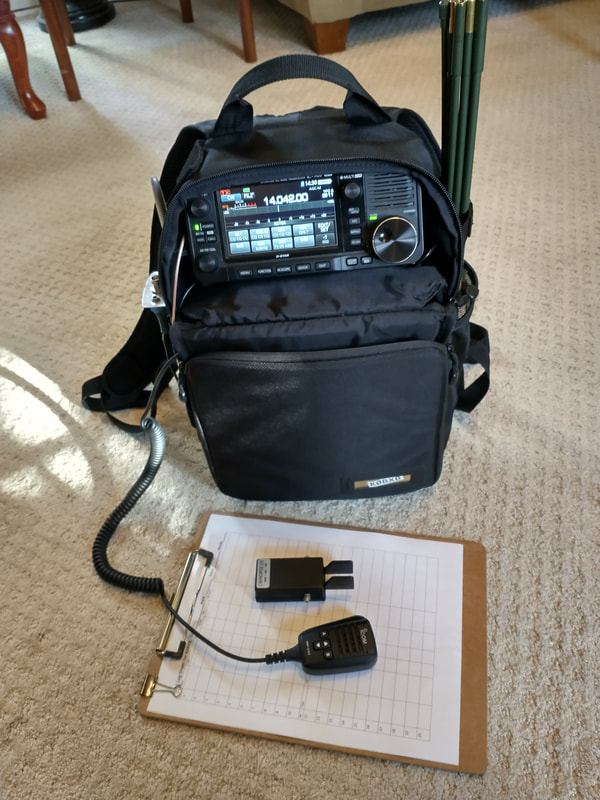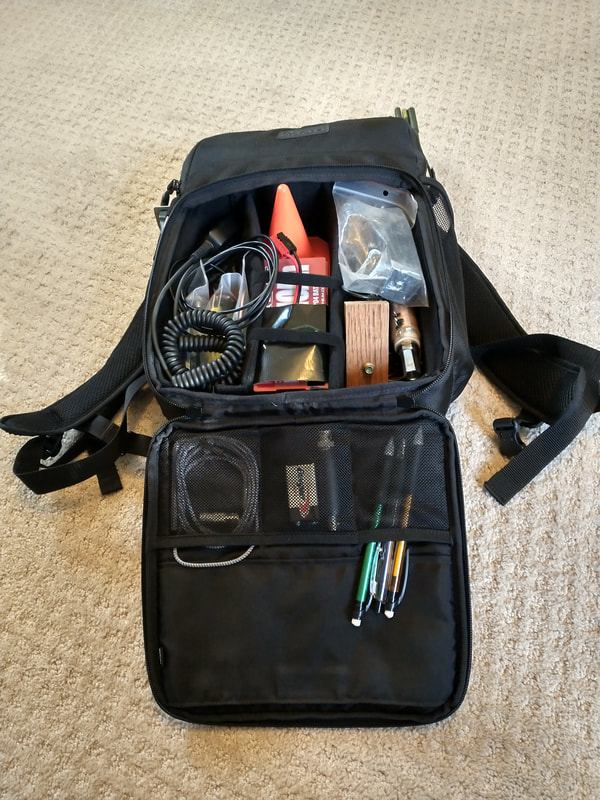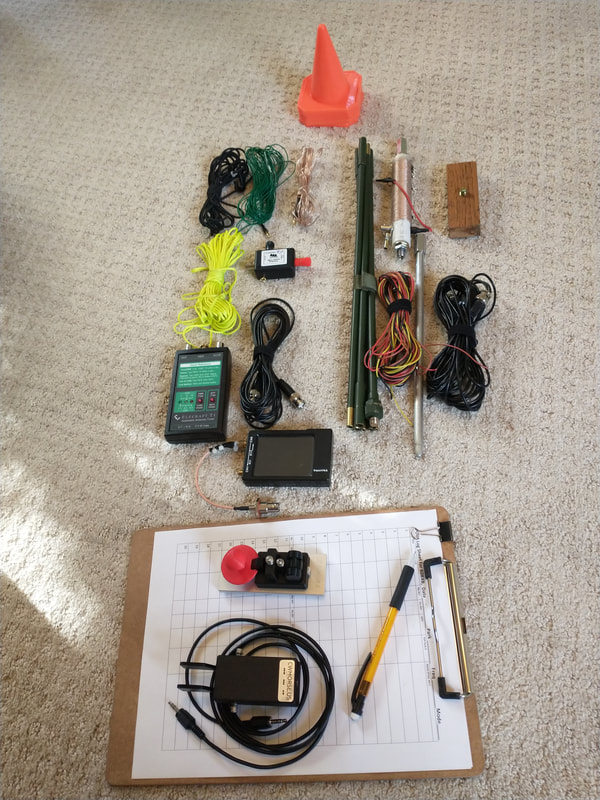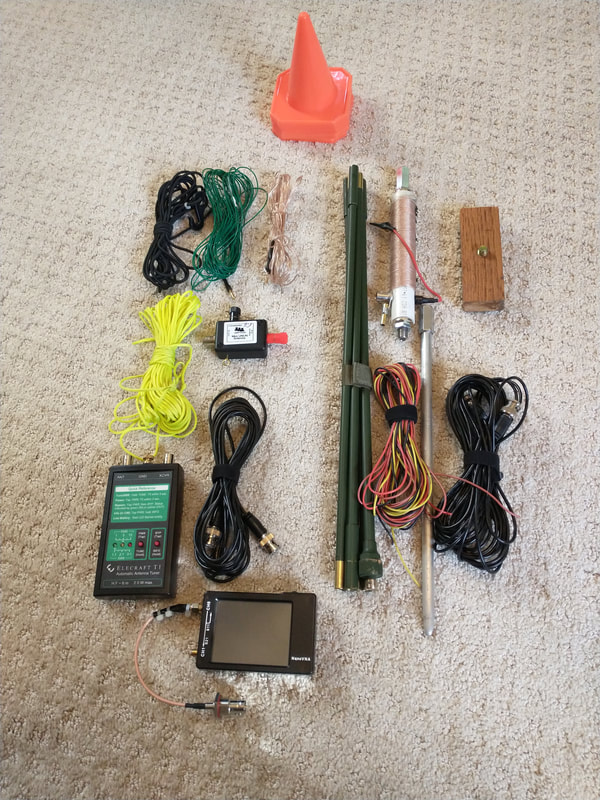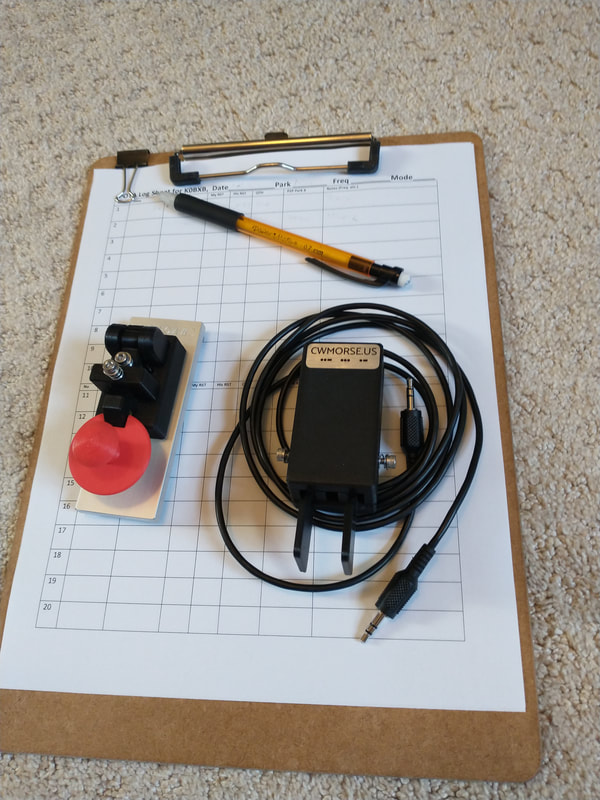My Ideal POTA Kit!
2024-05-10 It's been a little over a year since I went exclusively QRP. What fun! I don't think it's cost me much in terms of numbers of log book entries. Sure, there are some stations I couldn't work, especially DX, but that's likely due to my antennas as much as power output!
The fun part is symbolized by this picture. The magic, the excitement, the joy of playing with tiny, inexpensive gear like this trusdx with similar contact results as with my ic705!
Now to do a POTA Activation with it! See you from a park, soon! Martin, K0BXB
The fun part is symbolized by this picture. The magic, the excitement, the joy of playing with tiny, inexpensive gear like this trusdx with similar contact results as with my ic705!
Now to do a POTA Activation with it! See you from a park, soon! Martin, K0BXB
I'm learning that a lot of factors play into "Ideal". This rig makes an issue of size which is an important consideration. And though itself is amazingly small it does require an external battery, likely a speaker and perhaps an antenna tuner. Add those things and it's not as "small" as one thinks. All that is incorporated in my ICOM IC705 which is several times larger and heavier. So, what's ideal? You'll have to answer that for yourself.
2023-07-07 I've had the GRA-7350TC antenna for a couple weeks now and am very pleased with it. Did my fifth POTA activation with it this morning. Bands seemed a bit "down" today. Took 55 minutes to get 12 CW POTA contacts at k-4265. Ten watts with my ic705 and GRA-7350TC antenna. Started about 11:15am on 40 meters and eventually got two. Tried 30m, no luck. 20m was much better. 17m got one. It was fun even though slow and now I have five activations with this radio/antenna combination. We're heading to Kansas from Wisconsin in a couple weeks for a family reunion. I'm planning to take this setup and do two or three activations. One brother-in-law is also a ham. Maybe I can finally get him into POTA!
Weighing just under ten pounds, the Menards tool bag contains the ic705 with an Elecraft T1 tuner attached, a 4.5Ah Bioenno battery, The GRA-7350TC antenna along with a 12" DIY ground spike, a WRC tripod hub with 12" legs and four ten foot radials. The bag also includes a 29' end fed wire antenna and the k6ark mini unun and 17' counterpoise. Two 25' feedlines are in the bag, the primary one is rg316. The backup is rg174. A miscellaneous bag with the mic and several cables and a nanoVNA is included. I operate primarily CW so two N6ARA mini paddles are in the bag. I log with my phone using HAMRS but just in case, a small notebook and a couple pencils are there too. Believe it or not, there is still room for a candy bar!
2023-06-22 I'm on a continual quest is for simplicity and ease of transport and setup. I'd like to grab one light weight bag and have everything needed to be on the air quickly, simply and effectively. The 9' foldable whip with ground spike comes close though it's 18" collapsed length is a bit long! End fed antennas also come close but they need either a portable mast or depend on trees or something similar. QRP Guys DS1 or Elecraft AX1 come very close but are on the low end as far as effectiveness. I use them both for pedestrian mobile with impressive results. I'm waiting for a GRA-7359T. It holds a lot of promise as it's collapsed/disassembled length is quite small yet has a nearly 9 ft extended length. It's just a personal challenge. Part of the fun!
2023-06-12 As is evident from this page, an ideal portable kit does not exist, or at most it doesn't exist long before being significantly altered or superseded by "a better idea!" So this is my latest "better idea!" The heart and soul is my ICOM IC705 transceiver. everything circulates around it. It is mounted on a L-shaped frame made from an old clip board and a couple heavy L-brackets. That, along with the large eye bolts on each end and a flip-down "stand" on the under side allow me to use the radio without modification stand-lone on a picnic table or in my shack, attach straps and use it pedestrian mobile or put it in a bag and take it to a park to operate from a picnic table.
The kit in the bag consists of the radio, an Electaft T1 tuner attached to the top of the radio velcro like straps, a 4.5Ah Bioenno battery, 35' of rg316 coax and two antennas. The antennas are a 40-10 EFHW made with the kit from KM4ACK and a 29' end fed based on the K6ARK mini 9:1 unun. I work mostly CW and the CW key is by N6ARA. It is perfectly matched to the ic705, plugging directly into the key jack on the righ side of the radio, no wires required.
The only things required to get on the air NOT inside the bag is the antenna mast and stand. The mast is an approximately 24' fiberglass fishing pole and the stand is a DIY thing I made up. It works as a drive-on stand or free standing. I usually have two or three bricks to put on the stand in case of wind. I also use my phone to log using HAMRS which is usually travels in my pocket rather than in the bag!
This kit is easy to carry, quick to set up and for me, works really well. Today I took it to k-4265 after lunch and came home about an hour and a half later later with 16 contacts logged, that includes the about 45 round trip drive and setup. And if I want to do pedestrian mobile, I simply take my small backpack with antenna and a battery along and I'm good to go!
2023-03-24 The three photos below show the current version of my Ideal POTA Kit. Left is the entire kit ready to walk our the door. It weighs just under ten pounds. The center photo shows the content consisting of 1) my ASUS E210 laptop, 2) IC705 radio plus extra battery pack, antenna tuner, K6ARA CW key and notepad. Finally there are two antennas: 29' End Fed with K6ARK 9:1 unun and some cord for pulling into a tree if needed, and my 9' foldable military style whip with DIY loading coil and 4 ten ft radials and a 12" ground spike. Also shown is a 33' RG316 coax.
The right photo shows the antenna set up two days ago at K-4265. Here I was using a WRC tripod with 18" legs rather than the ground spike. Not shown is my android phone which I use as a hot spot for spotting and logging. The kit is compact and contains everything needed to get on the air with CW.
2023-02-22 After six months using the portable kit I described back in August which grew out of my experience putting together a kit for pedestrian portable, I began thinking a few weeks ago about making some changes. I recently purchased an ASUS E210 11.1 inch laptop specifically for logging. I've been doing all my portable logging with my Android phone using the Hamrs app which I love that but for one reason, the keys on the Android virtual keyboard are quite small and make entering calls, etc. an error prone activity. The down side of the laptop, though small, it takes up more space. That is not a problem if one is sitting at a picnic table with space to spread out. But when sitting in a car during cold weather there is just not enough space for my all-inclusive kit plus the laptop.
|
The final motivation to try something different came when I did a couple activations with my Xiegu X5105 with an N6ARA tiny key plugged directly into the radio! THAT worked well. The left photo below shows everything fitting nicely on the thrift store chalk board on my lap in the front passenger seat of my Ford Escape! I began mulling over how i could duplicate that experience with my ICOM IC705. The center photo shows everything needed in a kit to do that with the ic705. The right photo shows it all packed neatly in a bag, ready to head out the door. I've done one activation with it and it worked nicely. More below.
|
I found the bag at a local thrift store quite a while ago. In fact I used it when I traveled to Arizona from Wisconsin back in January of last year. About the only difference between the Arizona kit and this one is I included a 4.5Ah Bioenno battery and did NOT take a laptop. The antenna I used then was a 9' vertical with a DIY loading coil. The activation was successful and fun. By the way TSA didn't have any problem with the kit. The only interest shown was in my foldable 9' whip!
My new kit does not include an external battery as I've opted for 5 watts only using the ICOM stock BP-272 1.9Ah Snap-On battery. I do include the larger ICOM BP-307 3.1Ah battery giving me a total 5Ah of battery capacity, more than enough for my style of activating, albeit at 5 watts rather than 10w.
I have two antennas included in the kit. The primary one is the EFHW from KM4ACK. Trimmed for 40-10 meters and with two links for 30 and 17 meters it weighs just 6 ounces. And since it it resonant on 40, 30, 20, 17, 15 and ten meters, no tuner is required. I usually set it up as an inverted vee using a fiberglass collapsible fishing pole about 20' long. The antenna is so light weight that the ends can be tied off to almost anything, including a conveniently located weed using 1/8' bungee cord and cord locks. The result is a very good, easy to deploy antenna requiring no tuner.
My other antenna uses the K6ARK small 9:1 unun with a 29' radiating element and a 17' counterpoise wire. Both wires are made from SOTABEAMS lightweight antenna wire, about 26 gauge. Its tough, relatively tangle free and just works well. This antenna does require the tuner but can be used on all HF bands. I've used it a lot and really like it. Performs well and its band agility is wonderful. Being super light weight the end can be tied off to almost anything, again using 1/8" Bunge cord.
Three other antenna related items are my Elecraft T1 tuner with a 12" RG316 coax to connect it to the radio. The T1 is very small and will tune anything. The second item is a NanoVNA. Seldom use it but it is nice to have in case everything goes wrong. Finally I carry a 30' RG316 coax. On a longer absence from home I will likely toss in a 25' RG316 coax as well. Finally, I usually take along a 15' RG174 coax just in case.
For a CW key, I work mostly CW, I carry two options. My first choice is the N6ARA tiny key plugged directly into key jack on the IC705. For a backup I use a DIY paddle which is a much modified Whiterook Products Model MK-44. It's very small and light but has a very nice touch.
I seldom run FT8 though I can so along with the laptop I take a USB cord to interface with the radio. And I use my phone as a hotspot for logging so I take a USB cord to connect the laptop and phone.
The only custom item for this kit is a flip-down stand to tilt up the radio. I fabricated it from a small piece of material cut from an old clip board and an old reclaimed hinge. The hinge screws onto the bottom with a 1/4 bolt so that the 1-1/2 inch "board" can fold back under the radio so it will fit into the bag. It simply flips down to for the tilt stand for the radio with in use.
In conclusion, I've only used this setup on one activation, sitting in the front passenger seat of my car. I used the EFHW on 15 meters so didn't need the tuner. Worked very well with 19 contacts in little under an hour. I've used it set up on my desk at home for a hundred plus contacts using my G5RV with the T1 tuner. I'm sure I'll make some refinements but those aren't obvious yet!
2022-10-04 I've activated k-4265 Richard Bong State Recreation Area ten times with 153 contacts recently. 73 of those contacts were with my EFHW antenna, 49 with my Wolf River Coils vertical and 31 with my 29' end fed antenna. 56 were on 40 meters, 25 on 30 meters 67 on 20 meters. The remaining five were on various other bands. 120 were using CW with 33 SSB. Bong is only a few miles from our home so is really easy to get to. I usually spend only a couple hours at most and make around a dozen contacts each trip. So I'm not setting any records. My goals when I go out are to have a relaxing time and make at ten least contacts. I'm not trying for exotic stations or long distances. For me a contact is a contact and should I get one that stands out, great. The longest distance these past few weeks was 1,851 miles to California with the average being in the 500 to 1000 range. Here are a few observations from my recent activations at Bong.
Location. I've activated two other locations in this same time frame but Bong got by far the most attention because it is so convenient. It is also a very easy place to set up. Lots of picnic tables in nice locations with plenty space for nearly any antenna. Driving several hours alone to a park is not likely to happen for me very often. Too many other things going on in life. But I did mange to squeeze in an activation while visiting family in Michigan and and another in Iowa on the way to visit family in Kansas. Both were fun. But Bong is an ideal park for a POTA Activation site for me because of its location.
Gear. I need my gear to be small, light, easy to take along and easy to deploy once there. I've pretty much settled on my ic705 transceiver with an Elecraft T1 tuner. Both, along with a 3aH battery and CW paddle are mounted on a DIY frame which slips into a canvas "tool bag" along with both a very light weight 29' end fed and a light weight EFHW as well as feedline, etc. The loaded bag weighs 9lbs and has handles to make carrying easy. That plus an antenna mast/support is all I need.
Antennas. Your antenna can be as complicated or simple as you want to make it. I lean toward the simple! If I use one of the light weight wire antennas in my gear bag, then all I need in addition is a tree or other support. I usually take a carbon fiber or fiberglass collapsible fishing pole with a DIY free standing support. That is light weight and easy to carry. If there is wind I'll find a couple rocks or take along a couple bricks to hold it upright. I usually have my Wolf River Coils mini coil and17 ft whip in the car which is easy to set up and requires little space. That is another simple option. Simplicity and ease of carrying and setting up are the keys for me. As things get more involved and cumbersome, the less likely I am to go out!
Mode. I like things simple so have not done FT8 or other digital modes in a park. I stick with CW and SSB. The need for a laptop, more setup, cables, etc. are deterrents to me. Perhaps I'll progress into that? Not sure.
Logging. I started out doing paper logs. They are easy and more or less foolproof. A safe way to go. I now us the app VLS logger on my Android phone. I already have and use the phone for spotting and looking for spots so it adds little complication to the whole process. If you want to VLS logger or some other app, I would encourage you to use it at home to get get familiar and comfortable with it. And, at least initially, have paper and pen nearby as one can get flustered in "the heat of battle"!
I hope the above is interesting and perhaps helpful. Yesterday demonstrated how well this all works for me. I left home at about 1:45 and was at the parking lot about 2:10. Logged my first contact at 2:34. Got my 13 contacts and was back home at about 3:45.
2022-10-12 Just a couple comments about antennas for my "ideal" POTA kit. Below I referred to my 29' end fed as an "when all else fails" option. Based on my past few activations, I want to upgrade it to at least 2nd choice level! I used it for my last four activations and made 69 solid contacts. I set it up as a sloper using the K6ARC mini 9:1 unun. It was amazingly easy to set up whether I connected the directly to the T1 tuner or used a 35' RG316 feedline. It was really nice to be able to simply hit the tuner button to use it on any band. No links to fuss with or whip to adjust, just a quick tune and all was good. I made contacts on 40, 30, 20 and 17 meters. So, I may put the EFHW in my antenna bag and use the 29 footer more often! This does make an important point. The "best" antenna is very much a combination of location, time available, and personal choice. No one antenna fits all!
2022-08-13 After several years of doing POTA, both hunting and activating I have refined my "ideal" kit considerably. This one is what I've used exclusively now for several months with only a few small refinements as a result of use.
First the rig, pictured below includes an ICOM IC-705, Elecraft T1 tuner, Bioenno 3Ah LiFePO4 battery, CWMORSEUS paddle key and ICOM HM-243 mic.. I've made a custom frame so all these items are "permanently" mounted and easily accessible. The idea for the frame and overall configuration came out of my effort to build a pedestrian mobile setup. The link highlighted in the previous sentence discusses the evolution of the kit to meet the unique requirements of operating pedestrian mobile. But once I had it working I realized most of those requirements were also valid for most portable operating whether at a picnic table, holding the rig on your lap or whatever. I now use it in the shack as well. The "at-hand" nature of the tuner, phone and key make it really easy to use. The fact that it takes up minimal space is an added blessing!
It's kind of hard to describe the construction. Hopefully the pictures give a reasonable idea. The left 2 photos are of the front as you see the rig when in operation. All user controls are on the front of both the tuner and IC-705 so you have full access to everything. And the phone is handy for logging, spotting, etc. The 3rdd photo is of the right side of the kit showing the battery cable and less visible, the cable from the CW paddle. The paddle is black so hard to see but are immediately below the blue foam strip on the top shelf and to the right of the IC-705. It is laying on its side, held in place with Scotch Restickable Dots on the bottom. A blue foam strip mounted on the underside of the top shelf presses the paddles against the bottom keeping it firmly in place. The paddle tips are flush with the bottom plate edge so somewhat protected when handling the rig. The 4th photo shows the left side of the assembly where the antenna and microphone connectors are located. Shown is a coax jumper between the IC-705 antenna jack and the T1 tuner, though most of the time I use resonant antennas when portable which connect directly to the IC-705. The last photo is of the back of the kit. To the left you can see the paddle. The blue item toward the right is the battery. It is held in place with Velcro. Finally, the "foot" or stand is simply a piece of plastic tubing that conveniently fits perfectly over a 10-24 nut making it easy to add or remove as needed. I put a 10-24 bolt with two nuts and a spacer in the bottom plate just for this purpose. When transporting the rig I remove foot so the kit lays flat.
I have pretty much settled on two antenna options for most of my portable operations. one, pictured on the left below is a Wolf River Coils TIA vertical with a Chameleon 17 ft whip. For radials I use four ten-foot 18 gauge silicone insulated wire connected at one end into a bundle with a banana plug (bullet connector) soldered there. I drilled a small hole into the tripod hub so I can simply plug the radial bullet connector in and fan them out like spokes of a wheel. As shown the WRC mini coil has a pigtail at the top which bypasses the coil. So for 20 meters I use that and make any SWR adjustments by adjusting the whip length. The two collars are set for 30 and 40 meters respectively. So with minimal adjustments I can quickly choose any band from 40 and 6 meters. This setup has served very well for hundreds of contacts in a variety of locations. It is also very quick to set up and take down. The picture shows the mini coil, 35' of RG-316 coax, the bundle of radials, the Chameleon whip and the three 24" WRC tripod legs.
The right hand photo is of my preferred antenna, based on the KM4ACK 40 meter EFHW antenna, shown on the orange wire winder. It is cut for 40 meters which gives 40, 20, 15 and 10 meters with no adjustments. I added two alligator-clip links, one for 30 meters and one for 17 meters. So it effectively covers all bands from 40 through 10 meters. The homebrew wooden stand can be used to support a collapsible fiberglass mast. Shown is my 22ft mast which I most often use. The stand can be used as a drive-on stand or free standing with a couple bricks on the cross piece if needed. Also shown are a couple tent pegs to tie off the antenna ends in the absence of a bush or tree, charcoal grill or something else! The black bundle in the middle is a length of 1/8 shock or bungee cord. The antenna wire is 24 gauge, very light so you don't need anything very sturdy to support it. Also shown is that 35ft length of RG-316 coax. This really is my antenna of choice. It's very easy to put up and take down and works very well. About the only time I use the WRC is when the situation just isn't 67ft wire friendly.
One of my biggest conundrums was how to pack all this for transport. As mentioned below I have the icom backpack which works well but won't handle conveniently my rig as described above. Walking through Menards, a local home store in our town I saw a big display of tool boxes, etc. Among them was a "Tool Bag." Made from canvas, pretty light weight and though I didn't have my kit with me, looked "just right" for it. It was only few dollars so I got one. It is perfect! It forms a real "grab and go" bag and weighs only 8-3/4 lbs, including the candy bars! As shown in the pictures below the ready-to-go bag includes the EFHW antenna and an extra 25ft RG-316 coax plus a small tablet and a couple pencils AND a worst-case 29ft random wire end fed antenna and a rolled up j-pole for 2 mtrs and 70 cmtrs. Backup up battery is provided by the snap-on pack on the back of the radio so the kit even includes backup battery power.
In conclusion, I know this isn't the perfect, ideal nor last word in a portable/POTA kit, but it's close for me. For the last five months it has been my setup for doing activations and for hunting from home using my G5RV. I've got another couple rigs but this one is just so easy to use that I migrate to it. So, "That's all folks!"
2022-05-25 We all know there is no "ideal" anything! That is especially true of POTA/Portable radio kits. With changes in available gear, experience and interests, the dream keeps moving further away. If you scan this page and the collection of pages under my Portable topic you will see how that has been and continues to be true for me. POTA or Parks On The Air has played a huge role in the growth and change of my portable operating, gear and thinking. In fact it now is the primary motivator of my whole ham radio interest.
For me the "kit" is includes everything I need to get to a location, set up and have a successful AND fun activation. Questions it has to address are things like completeness, flexibility in terms of modes, bands and physical situations, ease of transport, ease of setting up and braking down and just overall satisfaction with the whole experience. A kit is not something that can be "done." Tomorrow's activation may dictate considerable changes in what the kit includes and how it is assembled. Driving to a park likely provides more space and less demand on weights than when flying to a location commercially. Planning and adapting your kit in light of such issues is part of the fun, perhaps most of the fun!
The pictures above show some of the kits I've put together over the past few years. My latest one shown in the last three pictures, is based on what I learned doing pedestrian mobile. For pedestrian mobile I needed to mount the radio, key, tuner, mic and even my cell phone (used for logging) all on the "platform" on my chest so I could do everything with just one hand. Once I had that all figured out I found that even here in the shack it was really convenient! I then wanted to be able to take it out to do a portable operation. That in turn raised the question of what to carry it in to the location. That's when I discovered the MASTERFORCE tool bag at our local Menards store! It's just the right side. The kit includes the radio, bioenno 3Ah battery, Elecraft T1 tuner, key, mic, 30ft RG316 coax, 29ft random wire antenna and K6ARK 9:1 unun, K6ARK 40 meter EFHW antenna and a small bag of bungee cord and cord. Everything I need to do a multiband activation except an antenna support. Weighs 7-3/4 lbs.
I share this for two reasons. First, I just like to remember! Second, to encourage someone else to be creative, try different things and simply enjoy the ride. Things get boring if you don't keep changing!
2022-04-14 Yesterday was in the 40's with wind gusts of 50 mph, no POTA! So I decided to add 40 meters to my 20 meter pedestrian mobile antenna. It is one I made for my QRPGUYS DS-1 but works well on this one. My 20 meter coil has taps for other bands so I checked out the tap for 17 meters which seemed to tune OK. If it warms up a bit today I may check out the other taps as well. Should be fun when activating next time. I may just end up with a versatile antenna!
2022-04-14 My concept of "ideal" when it comes to a POTA kit is changing, perhaps broadening since playing with pedestrian mobile! See my Pedestrian Mobile A Reasonable Option page. The idea of strapping your whole station, including the antenna on your back and (and/or front) introduces whole new requirements compared with a kit designed to transport a semi-fixed station to an operating site. When pedestrian mobile, your body is the operating site! Most if not all of the ingredients or items required are the same, but how they are deployed is considerably different. And that has significant implications for "the kit."
I'm just beginning to think about how gear should be packed to transport it to "the jumping off point" for a pedestrian mobile activation. So far I've just tossed it in the car and taken off! but as I think about taking it on trips to visit family or maybe even fly to a location, that needs more thought and planning. Always something to think about with ham radio!
2022-03-10 The latest update to my POTA kit is the Ed Fong DBJ-2 Ham Portable Dual Band J-pole antenna. It is a very light weight 2m/70cm j-pole designed to be suspended from a tree branch or other support for portable operation. I've just had it a day but took it to K-4265 this afternoon to try it out. It was a brief test but I came home with my first two meter activation contact and learned a few things in the process.
|
2022-01-28 I'm zeroing in on the radio and antenna kit for the trip to Tucson, AZ the end of February for activating Saguaro National Park. I'm sure I'll make some changes before then but the gear in the photo to the right will likely be the core of the final package.
At the top is the bag I'll be carrying everything in. The three items immediately below the bag are 1) 10 meter (33 ft) of RG316 coax, 2) the K6ARK 29 ft end fed with a 17 ft counterpoise and 9:1 unun (green wire), 3) the KM4ACK 40 meter EFHW with alligator clip links for 30 and 17 meters (orange winder).
In the center is the ICOM IC-705 transceiver. I have the 3800 mAhr battery on the back. Immediately below the IC-705 is a 5v wallwart and micro usb cable for charging the IC-705.
To the left of the radio is a short RG174 patch cable, Elecraft T1 antenna tuner and extra battery. The T1 tunes the 29' antenna on almost all bands which makes it a very flexible antenna.
Across the bottom are my logging clipboard, pencil and CWMORSe US paddle and cable. On the left is a 15 ft length of 1/8 inch bungee cord which is very useful for tying off the antenna to almost anything! Not pictured is the microphone.
Finally, on the right side is my 15 ft carbon mast (fishing pole). It will support the EFHW as an inverted VEE or the 29' end fed as a sloper. Not pictured is my pre-bundled tree cord guy rope kit so I can erect the mast using just three tent pegs.
|
I do often also take along a spare paddle and cable and a 25 ft rg316 coax, a 25 ft or so small cord or rope as well as my NanoVNA in a separate bag. I might even include a 4.5Ah or 6 Ah 12 volt LIFEPO4 external battery and cable to give me the 10 watt option in that separate bag. I'm sure I'll make some changes to this kit as time goes on, but for now, it does the job nicely and only weighs around 7 lbs.
2021-12-29a After what I wrote earlier today about my small POTA kit based on the Xiegu x5105 I decided to see if I could put together a similar kit based on my ICOM IC705. The ic705 wouldn't fit into that nice little case I have my x5105 in but I found another bag that was just right. My logging clipboard sits against the back of the main compartment. The radio fits nicely in the bottom of the main compartment on top of a folded Amazon shipping envelop. Another folded Amazon shipping envelop cushions and protects the top of the radio. Then a 33' RG316 coax, my QRPGuys 35' end fed antenna, the Elecraft T1 tuner and my CWMORSE paddle fit nicely on top of that. The microphone fits into the front pouch. Oh, a couple of mechanical pencils fit into the pencil pockets on the side! And the whole thing only weighs 5.1 lbs, just about a half pound more than the x5105 based kit. There is also room for a 4.5Ah Bioenno battery and cable in the top if you want the extra battery capacity. That brings the total weight to 6.5 lbs. The radio is limited to 5 watts output using only the internal battery but with an external battery it will put out 10 watts.
Not content to have it sitting on my bench, after lunch I quickly grabbed the bag, a bottle of water and a snack and headed to Park K-1440 near Lake Geneva, WI about twelve miles from home. I'm working on my POTA Kilo there! I left home about 12:50pm and I had to be back by 2:45pm at the latest. No time to waste! I arrived about 1:15pm. There was about two inches of snow on the ground and the temperature was 28 degrees, thankfully with little breeze. I operated from inside my car.
I set the rig up pretty much as I have been doing with my x5105 shown below, with the radio sitting on the door of the glove box. I quickly connected the RG316 coax to the radio and tossed it on the ground outside the passenger door. I had already set my DIY drive-on mast stand under the left rear tire with the 33' spiderbeams mast sitting in it so I quickly attached the far end of the antenna to the mast with some 1/8th inch bungee cord and cord locks and extended the mast. Then I finished unwinding the antenna out beyond the right front corner of the car where I secured it with another length of 1/8th inch bungee cord to a brick I had brought along. The unun was about six inches off the ground. Then I connected the coax.
Back in the car about 1:25 I finished connecting things out and tuning the antenna with the T1. 40 meters was crazy with a CWT contest, so I settled on 30m, selected 10.109, posted a spot on the POTA site and began calling CQ POTA. Had my first response at 1:31pm, W0SK in Tennessee. At 1:50, when I had to pack up, I had 13 stations in the log including one P2P in Idaho! Headed home at 2:15! Several people stopped by to ask what I was doing which was fun. Most had heard of ham radio but didn't know much about it. I was back home at 2:30, fifteen minutes ahead of schedule!
Observations? Everything worked very well. The ic705 is smoother operating than the x5105, even considering the T1 external tuner. And 5 watts with the internal battery worked as well on on the ic705 as five watts with the x5105! I noticed that the internal battery indicator on the ic705 showed I had used between 1/4 and 1/3 of the battery capacity which is a little concerning. I'm guessing 1-1/2 to 2 hours of operating would deplete it whereas the x5105 would probably last twice that long. That and the minor inconvenience of having to use the T1 tuner are the only two "issues" I could see with this setup compared with the x5105. Never thought I'd NOT use the LC192 backpack, as I really like it, but I'm going to stick with this kit for a while and see how it goes. I had the microphone with me but didn't use it.
2021-12-29 The last couple times out I took my x5105 kit which included my 35' version of the GRPGuys 9:1 unun based EF antenna. As I refine my winter deployment using my 10 meter (33 ft) Spiderbeams mast mounted in the DIY drive-on support it is quickly becoming my favorite POTA antenna. That is especially true when using the x5105 with internal tuner. It only takes about five or ten minutes to have the antenna set up and another few to hook up the radio, get out my log sheet, key, etc. and be ready to go. Furthermore, I'm having trouble seeing the five watt output of the x5105 as a problem, at least when operating CW. And I love the small, 4-1/2 lb total package, excluding the mast.
The very positive experiences I'm having with this setup is tempting me to try to use my IC705 similarly packaged! My deployments are typically less than an hour on the air so I'm sure the IC705 internal battery would perform well. My Elecraft T1 tuner wouldn't add much to the package. We'll see!
2021-12-21 This page is titled "My Ideal POTA KIT!" But as we all know there is no such thing. What seems ideal today may seem less so tomorrow. Something inspired me a few days ago to get out my Xiegu X5105 QRP radio. Part of what triggered that was thinking about my random length, or more correctly, my 29' end fed antenna. Since getting the IC-705 I've concentrated on resonant antennas which are very good but do confine one to whatever band or bands they are set up for. Yes some of them cover several bands, like my 40 meter EFHW. Several have taps or other ways to change their band of resonant, like my Wolf River Coils vertical. But they require getting some physical exercise, going to the antenna and changing a tap! But the random wire can be used on almost all bands if you have a tuner. And the X5105 has an excellent tuner built in.
Another nice thing about the x5105 is that it has a very respectable internal battery. So about all you need to operate is the radio, a key and cord (it has an internal mic), feedline and an antenna for a complete kit. In my case that package weighs just 4.25 lbs.
I used that nearly exact setup twice in the last week for two POTA activations and logged 46 CW contacts including Alaska and Porto Rico, 2700 and 2100 miles respectively. It was in the mid 30's and windy so it was nice to stay in my warm car when changing bands! Now I'm back to thinking, depending on ones criteria, this may be "My Ideal POTA KIT!"
2021-10-27 With just over 1500 Parks on the Air activation contacts in ten different parks here in the Midwest I've come up with a pretty stable portable package. I mean, nearly every time I head out it is with this kit. About the only customization may be antennas. But the basic single-bag kit includes everything I need including two dependable antennas. It's not quite "minimalist", weighing about ten lbs, but very portable. It provides for both CW and SSB on nearly every HF band and ten watts output. I haven't proven it but I think it will run between five and ten hours on the included battery. The primary antenna, a vertical, is stand alone. the other, a "random wire" end fed requires something to tie off the far end. I've logged 350 contacts between the two antennas with the furthest distance being just over 5000 miles. I'm pretty much assured of plenty contacts with either one every time I take the kit out. Of course there are always those times when that doesn't happen due to propagation or mistakes on my part. My point is, the kit is easy to transport, easy to set up almost anywhere, and just works!
Top row of photos.
1) The top left photo shows the pack complete and ready to be carried out the door. 2) The top center one shows how it would typically be set up for operating. Connect the key and antenna and all is good to go. I like the simplicity of that. 3) The top right shows the loaded pack open displaying the packed contents.
Bottom row of photos.
1) The bottom left photo shows the contents of the pack spread out. 2) The bottom center photo shows the two antennas. The left side is the random wire antenna and Electraft T1 tuner, since the ic705 does not have an internal tuner. Also shown is my NanoVNA, just in case! 3) The bottom right photo is of my clipboard with logging sheets, mechanical pencil, straight key and paddle with cable to connect the key to the radio. I normally use the paddle but have the straight key as backup. I do my logging manually.
Additional comments.
I fabricated a small aluminum bracket on the left side of the pack seen in the top left photo providing external antenna and key jacks. That significantly simplifies connecting the antenna and key. The vertical antenna ground mounting spike is shown on the left side of the pack behind the aluminum bracket. It is a 12" long 3/8" aluminum rod with a 3/8-24 coupling screwed onto top for attaching the vertical's loading coil. The foldable 9' whip of the vertical is collapsed and shown in the pocket on the right side of the pack.
The random wire antenna shown in the left half of the bottom center photo consists of a 29' wire radiator (green) 17' counterpoise (copper) and the QRPGuys mini 9:1 unun. The black bunge cord and yellow cord are for use in suspending the far end of the antenna. All random wire antennas need an antenna tuner, hence the Elecraft T1. The nanoVNA is for testing if either antenna seems whacky!
The small block of wood in the upper right of the bottom center photo is a comfort item. It screws on the top of the ground mounting spike to save your hand when pushing the spike into the ground! Click here for details on that antenna.
Final Remarks
I'm under no illusions that this is THE best portable kit. and it may not be my favorite for long! I also have a kit based on the Xiegu x5105 radio. It of course can be paired up with any of the other items, other than the T1 tuner as it has a very good internal tuner. I've logged over 400 contacts with it doing activations compared with just over 800 with the ic705. I also logged almost 500 of my activations using my Wolf River Coils vertical antenna with a 17' whip. It's an excellent antenna, probably better than either of these in my "ideal" kit but is not as convenient to transport or set up. I have about 15 activation contacts using a linked dipole. It is an excellent antenna but again is more difficult to deploy. And I've logged just over 300 contacts with 40 meter EFHW antennas, another excellent antenna but somewhat more difficult to set up and requiring more space. So I recognize this kit is a compromise of weight, transport and setup ease and power. For the moment, and about half of my activations the past couple months it has served me well. So for now....

